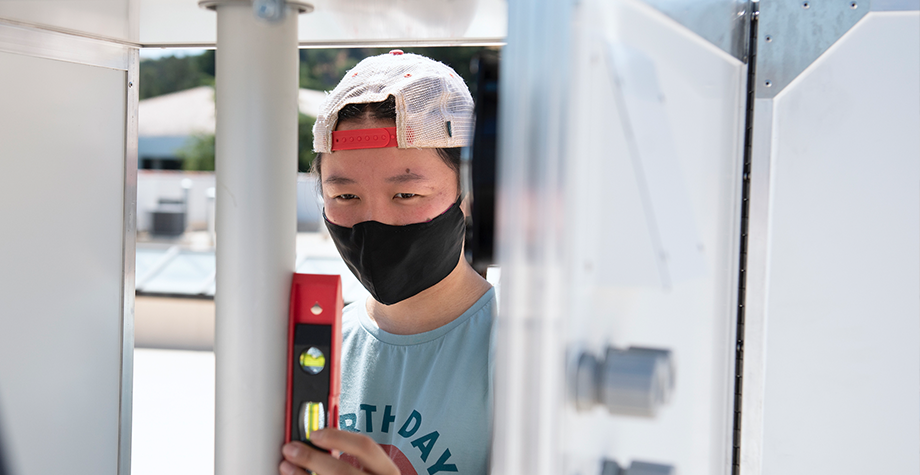
Esther Woo ’20 Impacts Air-Quality Measurement at Saint Mary’s
With wildfires raging and both children and adults wearing masks to restrict COVID’s spread, air quality has come to the forefront of every Californian’s mind. Saint Mary’s alumna Esther Woo ’20 focused on this issue during her senior year, as a result of her summer research project back in 2019 with Professor Joel Burley. During the 2019 fire season, she and Burley decided to deploy a temporary PurpleAir monitor at the PG&E tent to measure the air quality and then developed plans for a permanent air-quality station. Over the course of her final two semesters, she sent out cold emails, met with administration, and garnered support throughout the SMC community, ultimately raising more than $50,000 to install an air-quality monitor on campus. On the morning of June 24, after seven months of pushing through difficulties brought on by COVID-19, Woo stood on the roof of the Joseph Alioto Recreation Center to start the Teladyne air-quality monitor for the first time.
“It was very rewarding to be able to see the project to completion,” Woo said. “As a student, I was surprised to be at a table with President Donahue and [Vice Provost for Student Life] Jane Camarillo, discussing the importance of installing an air-quality monitor station. Dr. Burley supported me through the process and helped make this project happen.”
Before the installation of this permanent monitoring station, SMC had to estimate the air-quality in Moraga using Air Quality Index values from Concord and Livermore, and then factored in wind direction and climate. Now, the school will have a live reading as well as documented trends for the area. This information will help inform decisions to protect students, faculty, and staff from harmful conditions caused by smoke and other factors. In addition to measuring the main pollutant released by brush fires, PM2.5 (particulate matter less than 2.5 micrometers in diameter), the new monitoring station will also measure levels of ozone, nitric oxide, and nitrogen dioxide.
Professor of Chemistry Joel Burley, who has known Woo since she first considered attending SMC, served as her mentor while she researched the social justice implications of air pollution in the summer of 2019. He also supported Woo’s goals for a new monitor as they took shape last fall. “Working with Esther has been an amazing experience, and I am extremely proud of everything she has accomplished,” Burley said. “Her commitment to this project—and more generally, to environmental justice—has never wavered. She has been a force of nature, and we (her fellow inhabitants of planet Earth) have benefitted from her passion.”
In November 2019, the SMC student activist group End the Silence created a list of demands for the College, which included procuring a permanent air-quality monitor. The group had been aware of Woo’s research and included her in their discussions with administration. Woo obtained funding from the President’s Office, the Provost’s Faculty Research Fund, the Office of Mission, the Intercultural Center, the Catholic Institute for Lasallian Social Action (CILSA), Associated Students, the Contingency Fund, Facilities Services, the Disaster Preparedness Fund, and Professor Burley’s Fletcher Jones Grant.
“[The process] helped me get ready for grad school,” Woo said, “because now I know a lot about how the administration works, how I have to go about looking for funds for my research, and how to work with members of various departments to ensure that the installation is completed. A key part to research is making sure there’s also a next step for someone else to take over.”
Having graduated from Saint Mary’s in May with a bachelor’s degree in Biochemistry and a minor in Justice, Community, and Leadership, Woo spent her summer as a Chemistry Teaching Assistant, intern for the Alameda Point Collaborative through the MICAH Fellowship, and ingredient analyst for a start-up that provides transparency in the beauty industry. She is now beginning graduate school at the University of Michigan, working toward a Master’s of Science in Environmental Justice through the School for Environment and Sustainability. She hopes to research food insecurity and climate change issues. She plans on pursuing a PhD so that she can continue to advocate for marginalized communities and dismantle the cycle of poverty.